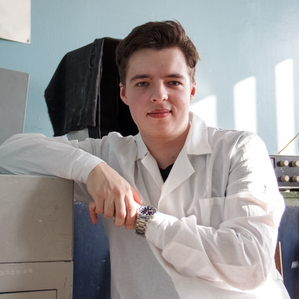The winners of the “UMNIK” federal program on identification and support of young scholars, who aim at self-fulfilment through innovational activities, were chosen. Among the prize-winners of the program, there are 10 young scholars of Samara University. One of the winners is the representative of the Faculty of Physics, a 4th-year student Ivan Shishkin.
Ivan Shishkin is developing the new technology of creating elements for solar panels using silicon. A solar panel represents a combination of photovoltaic (PV) converters, which transform solar energy in direct current. At the same time, solar panels are practically the only possible sources of energy for spacecrafts. High standards are set in space industry: solar panels should be light, radiation resistant, and profit-proved.
When manufacturing solar panels, Russian scholars have counted on silicon in contrast to foreign colleagues, who use germanium. Silicon has a number of advantages. First and foremost, its supply is accessible and practically unlimited as far as silicon dioxide is an ordinary sand. Secondly, silicon-based panels provide with a continuous service life as well as do not require labour-consuming costs during the production. Thirdly, silicon-assisted solar panels are five times cheaper than foreign germanium-based analogues.
Ivan Shishkin’s innovative idea lies in the following: he has suggested using a multilayer structure instead of a single-layer one, when manufacturing solar elements. Metaphorically speaking, solar elements, suggested by him, is a pie with silicon filling. Such restructuring helps increase an efficiency coefficient of solar panels from 15-17% to 22-25%, making them equivalent to existing market benchmarks.
Ivan Shishkin is planning to invest a ₽500.000 grant, obtained as a result of the competition, in the development of scientific-and-technical fundamentals of porous nanocrystalline silicon-based photosensitive structures technology of making. The silicon PV converters, which are being developed by the student, can be used not only in space industry, but also on Earth: the new solar panels can equip electric vehicles, mobile phones chargers, not to mention all onboard electronics.
Ivan Shishkin’s work was done under the guidance of Natalya Latukhina, Associate Professor at the Department of Radio Physics. This is a regular continuation of research of the materials for creating solar panels on spacecrafts, which is undertaken in Samara University. Such elements are now in test mode in outer space on “AIST-2D” small spacecraft, launched from the Vostochny Cosmodrome in 2016.
14 types of PV converters are currently tested on “AIST-2D” spacecraft. Among them, there are 2 check samples, made the traditional way, and the rest of them are experimental; they represent a multilayer structure, using nanocrystalline porous silicon and various coatings. 3 temperature-sensitive elements are attached to each sample whereas all incoming signals from the “AIST-2D” spacecraft are registered individually. The team of Samara University scientists, including Ivan Shishkin, processes the telemetry probing from the small spacecraft on a regular basis. These findings amend their further work on creating solar panels of the new generation.
For reference
The “UMNIK” program is targeted at young scholars and specialists. A ₽500.000 grant is given for 2 years for the purpose of conducting research and subsequent potential commercialization of the findings. Since 2007, 70.000 people have taken part and more than 12.000 have won the competition.
